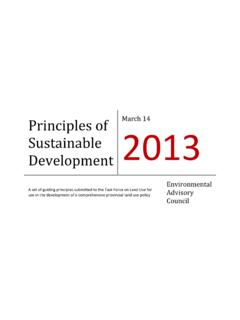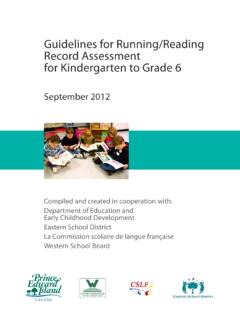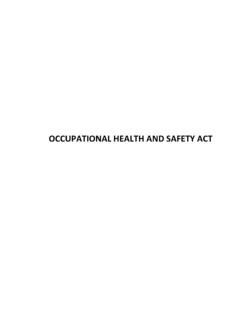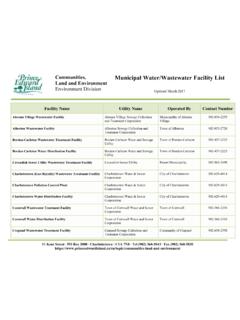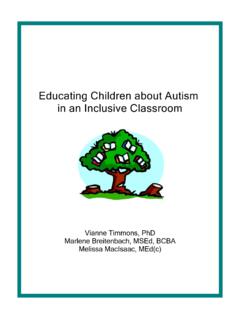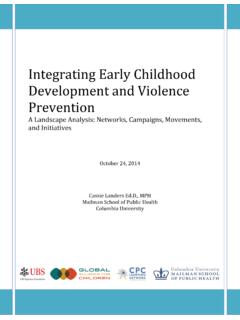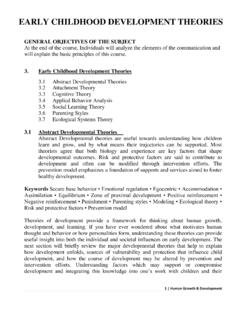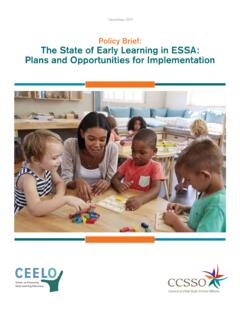Transcription of Education and Early Childhood Development
1 Working Toward Communication andInformation Technology LiteracyKindergartenWorking Toward Communication andInformation Technology LiteracyKindergartenJanuary 2011 DraftJanuary 2011 DraftWorking Toward Communication andInformation Technology LiteracyKindergartenWorking Toward Communication andInformation Technology LiteracyKindergartenJanuary 2011 DraftJanuary 2011 DraftEducation and EarlyChildhood DevelopmentEducation and EarlyChildhood Department of Education and Early Childhood Development , 2011 The document, A Journey (1997), first introduced the general concept of integrating tech-nology into the curriculum at the elementary level in Prince Edward Island.
2 As stated in this earlier document, using information technology in the schools was considered new and largely uncharted territory. We continue a journey into an interesting world of communication and information tools for teaching and learning. Journey On Grades 1-3 (1999) provided a framework and lesson plans for teachers at the primary level to integrate communication and information technology in their classrooms. Journey On Grades 4-6 (September 2000) and the document, Journey On Grades 7-9 (September 2000), continued with the same framework and specific grade level lesson plans intended for teachers in elementary and intermediate schools.
3 Journey On (2010), provides grade specific curriculum outcomes that have been assigned to core curriculum subjects. This kindergarten document contains specific technology out-comes, instructional considerations, teaching suggestions - activities and assessment strategies, lesson plans, and links to other curriculum areas. This document will serve as a guide for teachers. Lesson plans suggest specific exercises for classroom use and will serve as a starting point from which teachers may develop and enhance their own ideas and competencies in the area of communication and information technology (CIT).PrefaceJourney On - Department of Education and Early Childhood Development , 2011iiiAcknowledgementsThe Department of Education , Technology In Learning, gratefully acknowledges the sug-gestions, lesson plans, and other contributions made by Prince Edward Island students and educators.
4 The authors would also like to extend their appreciation to those individuals who provided feedback and editorial comments during the Development of this communication and information technology committees were instrumental in provid-ing input for the curriculum outcomes grades K-12 framework on which Journey On (2010) is based. Past and present members of the committees are listed below:Department of EducationJourney On - Department of Education and Early Childhood Development , 2011 Tami Jo AuldAnne CampbellJason CampbellBethany DoironLianne GarlandRobert GaudetBob GrayMarg GrayLaurie KingAnne IvesLori LaversDebbie MacLeanDr.
5 Kevin MacLeod Pam McIntosh-WhalenJoe MurphyTim MurphyLinda Shaw-PackardMarg StewartJoanne StubbsSusan WestphalKevin WhitrowB. J. WillisEastern School DistrictGuy AlbertTracy AndersonStella ArsenaultGordon BernardBruce BrineRobert BourgeoisGreg BungayPauline CoadyClayton CoeJoan ConnellDon CraigJudy DavisPeter GrisebauerFrank HennesseyLinda LowtherDoug MacDougallPercy MacGouganKim McBurney Lana MacIsaacEdward MacLeanTed NabuursAlaina Roach-O KeefeDanielle Plante-BourgeoisJeanette ScottElizabeth TumblinLaura BrakeLaurie CallbeckRalph CarruthersNancy DesRosiersKent EnglandMario FisetMarjorie HunterSally MacDonaldConnie McCabeDonald MulliganSergine OuelletGordon RamsayMark RonahanKeith TompkinsKristin TraceWestern School BoardFrench School BoardSylvain
6 Gagn University of Prince Edward IslandDr. Martha GabrielIntroduction Purpose of Definitions: Technology, Technological Competence and Technological Technology Integration .. Advantages of Technology s of Curriculum An Outcome-based Curriculum: Essential Graduations Learnings, and Specific and General Other Features of the General Outcomes for Communication and Information Specific Outcomes for Communication and Information to Use this Document, Paper vs. of Communication and Information Technology in Kindergarten Computer Systems .. Social, Ethical and Health .. Internet .. Concept Maps .. Graphics.
7 Word Processing .. Multimedia .. Database .. Telecommunications .. Web Authoring ..Lesson Plan ..Glossary ..Contents124567810212428323436384042444 6496870 Journey On - Department of Education and Early Childhood Development , 2011iiiivVisionTechnology Education for Atlantic Canada fosters the Development of all learners as tech-nologically literate and capable citizens who can develop, implement, and communicate practical, innovative, and responsible technological solutions to On - Department of Education , 2010 Foundation for the Atlantic Canada Technology Education Curriulum, APEF, Pg. 51 Journey On - Department of Education and Early Childhood Development , 2011 IntroductionPurpose of DocumentJourney On is a practical working guide which will provide educators and administrators at all levels, including schools, school boards/districts, and provincial departments, with a reference point for integrating communica-tion and information technologies (CIT) into the Prince Edward Island school cur-riculum.
8 Journey On will be the basis for future deci-sions pertaining to human and physical CIT resources. These decisions will focus on personnel, professional Development , in-structional techniques, course Development , student and teacher access to technology, and hardware and software is recognized that many disciplines have their own specialized technologies and technological processes. Students will have the opportunity to develop skills required to use these specialized technologies within the context of courses such as Computer Science, Science, Career Exploration, Visual Communication, Industrial Arts, and Home Economics.
9 CIT differs from other tech-nologies because of its vast and far reach-ing applications in all disciplines. The purpose of Journey On is to focus on how CIT can be used from K-12 and across all areas of the curriculum as part of a more global strategy that will contribute to the Development of technologically competent and literate individuals graduating from our school system. Journey On: provides strategies and concrete sug-gestions for effective integration of communication and information tech-nologies into the Prince Edward Island curriculum in a way that enhances learning identifies the communication and information technologies that we wish our students to use identifies the knowledge and skills that students need to develop to be considered technologically competent in communication and information technologies2 Journey On - Department of Education and Early Childhood Development .
10 2011 TerminologyTechnologyThe b road definition of technology includes the tools and processes we use to alter our surroundings, perform a task, discover more about ourselves, and communicate. For the purpose of this document technology refers to the tools used to access, gather, process, and share information. These communica-tion and information technologies (CIT) pertain to computers and their peripherals such as scanners, printers, digital cameras, projection devices, and video-conferencing equipment. Technological CompetenceThe Atlantic Provinces Educational Foun-dation (APEF) defines technological com-petence as the ability to use a variety of technologies, demonstrate an understanding of technological applications and apply ap-propriate technologies for solving problems independently.
